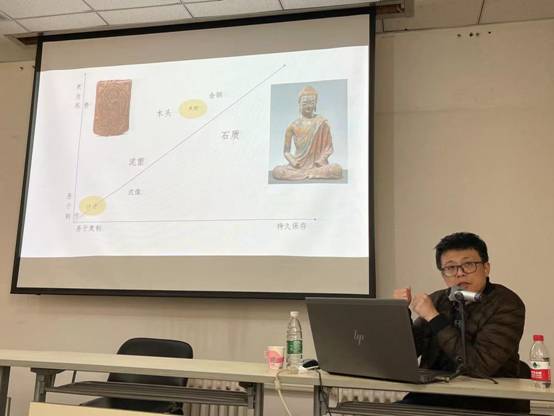

Professor Lin Weizheng, from the Art History Department of the University of Chicago delivered an academic report entitled "Material, Size and Craft -- What can we learn from the Materiality of Ancient Chinese Buddha Statues" in D204 of the Art College, which was presided over by Dean Zhao Hui on the morning of April 28, 2021. The participants including teachers majoring in relevant subjects, graduate and undergraduate students, showed great interest in this lecture, filling up the venue.
Professor Lin’s main research area is the history of Buddhist art and architecture in Medieval China and he published "Architectural Feat: Buddhist Architecture on Mount Wutai in China" in 2014. In addition, he has published dozens of academic papers on the history of Chinese tomb art history, Chinese architectural history, Chinese Visual material Culture and many other fields in both Chinese and English.
Professor Lin believes that from the perspective of Buddhist doctrine, the material of Buddha statue is not that worth discussing, as long as there is "grant appearance and figure", any material of Buddha Statue can be called the exact portrait of Buddha. However, in reality, there are many kinds of material of Buddha Statue, and providers do have many considerations when choosing Buddha. It can be seen from the collections of major museums in the world that the materials of Buddha statues gradually became diversified after the Southern and Northern Dynasties. The characteristics of diverse materials and the corresponding production methods determined the significance of different Buddha statues. From the perspective of different materials and crafts in the East and West, Professor Lin analyzed many representative cases of different Buddhist statues in the middle ages of China. He believed that there was actually a value system for judging the material of Buddhist statues in the middle ages, which was used to express the relationship between "image" and "presence". Professor Lin's lectures were simple, humorous and rich in images and texts, providing an academic feast for all participants.
The material and craft of Buddha statues delivered by Professor Lin aroused further discussion among teachers and students, who were eager to learn more about the subject, interacting with the professor enthusiastically. Professor Lin gave clear and accurate answers to everyone's confusion, benefiting both teachers and students a lot.